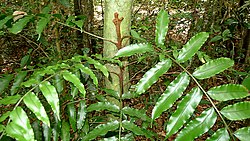| Lomariopsis | |
|---|---|
 | |
| Lomariopsis marginata | |
| Scientific classification | |
| Kingdom: | Plantae |
| Clade: | Tracheophytes |
| Division: | Polypodiophyta |
| Class: | Polypodiopsida |
| Order: | Polypodiales |
| Suborder: | Polypodiineae |
| Family: | Lomariopsidaceae |
| Genus: | Lomariopsis Fée [1] |
| Type species | |
| Lomariopsis sorbifolia (von Linné) Fée | |
| Species | |
| Synonyms [1] | |
| |
Lomariopsis is the type genus of the fern family Lomariopsidaceae. [2]
Contents
One economically important species exists via the freshwater aquarium plant trade, having only just been introduced in 2001 as an aquatic gametophyte form; most commonly known as " süsswassertang " (German for "freshwater seaweed"), this plant was initially believed to be some sort of liverwort. However, it is closely allied to Lomariopsis lineata , but has not yet been named as a distinct species.[ citation needed ]